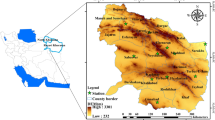Abstract
Using NDVI data of NOAA-AVHRR in recent 20 years and the temperature and precipitation data of West China, the vegetation activity is discussed by adopting the EOF and REOF decomposed functions. Results show that the overall increasing trend of vegetation activity in different seasons reflects an advanced and prolonged growth period of vegetation under the circumstance of climate warming, but the vegetation evolvement has much inconsistency between different regions and seasons. There are four notable regions, eight sub-areas for vegetation evolvement in spring and summer, and nine sub-areas in autumn. The vegetation activity in most sub-areas is increasing. The most notable region is represented by Lhaze station on the Tibetan Plateau. Two other marked stations are represented by Altay station in Xinjiang Uygur Autonomous Region and Pengshui station in Sichuan Province. But the time series analysis of NDVI makes clear that the trends of the other two sub-areas, Turpan station in Xinjiang and Huashan station in Shaanxi Province, are descending. It is an important reason for vegetation evolvement that temperature ascends in most of the regions and descends in the east region in some seasons. But another important reason for vegetation evolvement is that precipitation is ascending in the west and descending in the east of the region.
Similar content being viewed by others
References
Cramer W P, R Leemans, 1993. Assessing impacts of climate change on vegetation using climate classification systems. In: Solomon A M, Shugart H H (eds.), Vegetation Dynamics and Global Change. London: Chapman and Hall, 190–217.
Fang J Y, A P Chen, C H Peng et al., 2001. Change in forest biomass carbon storage in China between 1949 and 1998. Science, 292: 2320–2322.
Gong Daoyi, Shi Peijun, He Xuezhao, 2005. Spatial features of the coupling between spring NDVI and temperature over northern hemisphere. Acta Geographica Sinica, 57(5): 506–514. (in Chinese)
Keeling C D, J F S Chin, T P Whorf, 1996. Increasing activity of northern vegetation inferred from atmospheric CO2 measurement. Nature, 382: 146–149.
IPCC, 2001. Climate change 2001: the scientific basis. In: Houghton J T, Ding Y H, Griggs D J (eds.), Contribution of Working Group I to the Third Assessment Report of the Intergovermental Panel on Climate Change. Cambridge, UK: Cambridge University Press, 881.
Liu Yujie, Yang Zhongdong, Guo Huadong, 2002. Theory and Method of Disposal of Remote Sensing Information of MODIS. Science Publishing Company, 1–346.
Ma Mingguo, Jiao Yuanmei, Cheng Guodong, 2002. Change in land coverage in Northwest China during the past decade monitored by NOAA-CHAIN. Journal of Glaciology and Geocryology, 24(1): 68–72. (in Chinese)
Myneni R B, C D Keeling, C J Tucker et al., 1997. Increased plant growth in the northern high latitudes from 1981–1999. Nature, 1997, 386: 698–702.
Myneni R B, Tucker C J, Asar G et al., 1998. Interannual variations in satellite-sensed vegetation index data from 1981 to 1991. Journal of Geophysical Research, 103(D6): 6145–6160.
Piao Shilong, Fang Jingyun, 2003. Seasonal changes in vegetation activity in response to climate changes in China between 1982 and 1999. Acta Geographica Sinica, 58(1): 119–124. (in Chinese)
Sellers P J, B W Meeson, F G Hall et al., 1995. Remote sensing of the land surface for studies of global change: model-algorithms-experiments. Remote Sensing of Environment, 51: 3–26.
Tucker C J, I Fung, C D Keeling et al., 1986. Relationship between atmospheric CO2 variations and a satellite-derived vegetation index. Nature, 319: 195–199.
Zhang Jie, Wang Jiemin, Guo Ni, 2004. Atmospheric correction of visible to middle-infrared of EOS-MODIS data over land surfaces. Quarterly Journal of Applied Meteorology, 6(4): 651–657. (in Chinese)
Zhang Qiang, Hu Yinqiao, 2002. Geography character of oasis and domino of climate. Advance in Earth Sciences, 17(4): 477–486. (in Chinese)
Zhou L M, C J Tucker, R K Kaufmann et al., 2001. Variations in northern vegetation activity inferred from satellite data of vegetation index during 1981 to 1999. Journal of Geophysical Research, 106: 20069–20083.
Author information
Authors and Affiliations
Additional information
Foundation: National Natural Science Foundation of China, No.40205014; No.40175004; Project of Gansu Province, No.3ZS051-A25-011; Item of the Ministry of Science and Technology, No.2004BA901A16; No.2004DIB5J192
Rights and permissions
About this article
Cite this article
Zhang, J., Zhang, Q., Yang, L. et al. Seasonal characters of regional vegetation activity in response to climate change in West China in recent 20 years. J GEOGR SCI 16, 78–86 (2006). https://doi.org/10.1007/s11442-006-0108-0
Received:
Accepted:
Issue Date:
DOI: https://doi.org/10.1007/s11442-006-0108-0



